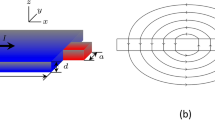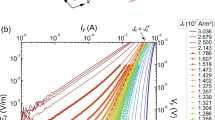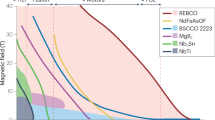Abstract
When a magnetic field is applied to a type-II superconductor, it penetrates the sample in localized tubes of magnetic flux associated with quantized current vortices; under appropriate conditions, these vortices form an ordered lattice. In a material free of crystal defects, transport currents force this lattice to move and dissipate energy, giving the material a non-zero resistance. The presence of defects, however, can inhibit vortex motion, or even pin vortices to specific locations. Thus, to engineer materials with improved properties it is important to understand the motion of a driven vortex lattice in the presence of different kinds of pinning defects1,2. Recent research has investigated vortex-lattice dynamics in the cases of weak, uniform pinning and strong but non-uniform pinning. Here we consider a different regime, in which the barriers to vortex motion at sample surfaces3 also play a crucial role. Our experiments on clean, detwinned YBa2Cu3O7–δ crystals at temperatures around 80–90K reveal an interplay between surface pinning and weak bulk pinning that leads to the formation of a defect superstructure in the vortex lattice. This current-induced organization is similar to phenomena observed in the dynamics of sliding charge-density waves, and represents a fundamentally new kind of vortex dynamics.
This is a preview of subscription content, access via your institution
Access options
Subscribe to this journal
Receive 51 print issues and online access
$199.00 per year
only $3.90 per issue
Buy this article
- Purchase on SpringerLink
- Instant access to full article PDF
Prices may be subject to local taxes which are calculated during checkout
Similar content being viewed by others
References
Jensen, H. J., Brass, A. & Berlinsky, A. J. Phys. Rev. Lett. 60, 1676–1679 (1988).
Yaron, U. et al. Nature 376, 753–755 (1995).
Burlachkov, L. et al. Phys. Rev. B 50, 16770–16773 (1994).
Gagnon, R., Lupien, C. & Taillefer, L. Phys. Rev. B 50, 3458–3461 (1994).
Braun, D. W. et al. Phys. Rev. Lett. 76, 831–834 (1996).
D'Anna, G. et al. Phys. Rev. Lett. 75, 3521–3524 (1995).
Sarkardei, M. R. & Jacobs, R. L. Phys. Rev. E 51, 1929–1932 (1995).
Tang, C., Wiesenfeld, K., Bak, P., Coppersmith, S. & Littlewood, P. Phys. Rev. Lett. 58, 1161–1164 (1987).
Coppersmith, S. N. & Littlewood, P. B. Phys. Rev. B 36, 311–317 (1987).
Fleming, R. M. & Grimes, C. C. Phys. Rev. Lett. 42, 1423–1426 (1979).
Dumas, J., Schlenker, C., Marus, J. & Buder, R. Phys. Rev. Lett. 50, 757–760 (1983).
Grüner, G. & Zettl, A. Phys. Rep. 119, 117–232 (1985).
Author information
Authors and Affiliations
Rights and permissions
About this article
Cite this article
Gordeev, S., de Groot, P., Oussena, M. et al. Current-induced organization of vortex motion in type-II superconductors. Nature 385, 324–326 (1997). https://doi.org/10.1038/385324a0
Received:
Accepted:
Issue date:
DOI: https://doi.org/10.1038/385324a0
This article is cited by
-
Bound vortex dipoles generated at pinning centres by Meissner current
Nature Communications (2015)
-
Flux Dynamics and Time Dependent Effects in Superconducting MgB2
Journal of Superconductivity and Novel Magnetism (2012)
-
AC current driven dynamic vortex state in YBa2Cu3O7-x
Applied Physics A (2007)
-
Dynamic instabilities and memory effects in vortex matter
Nature (2000)
-
Transport properties governed by surface barriers in Bi2Sr2CaCu2O8
Nature (1998)



